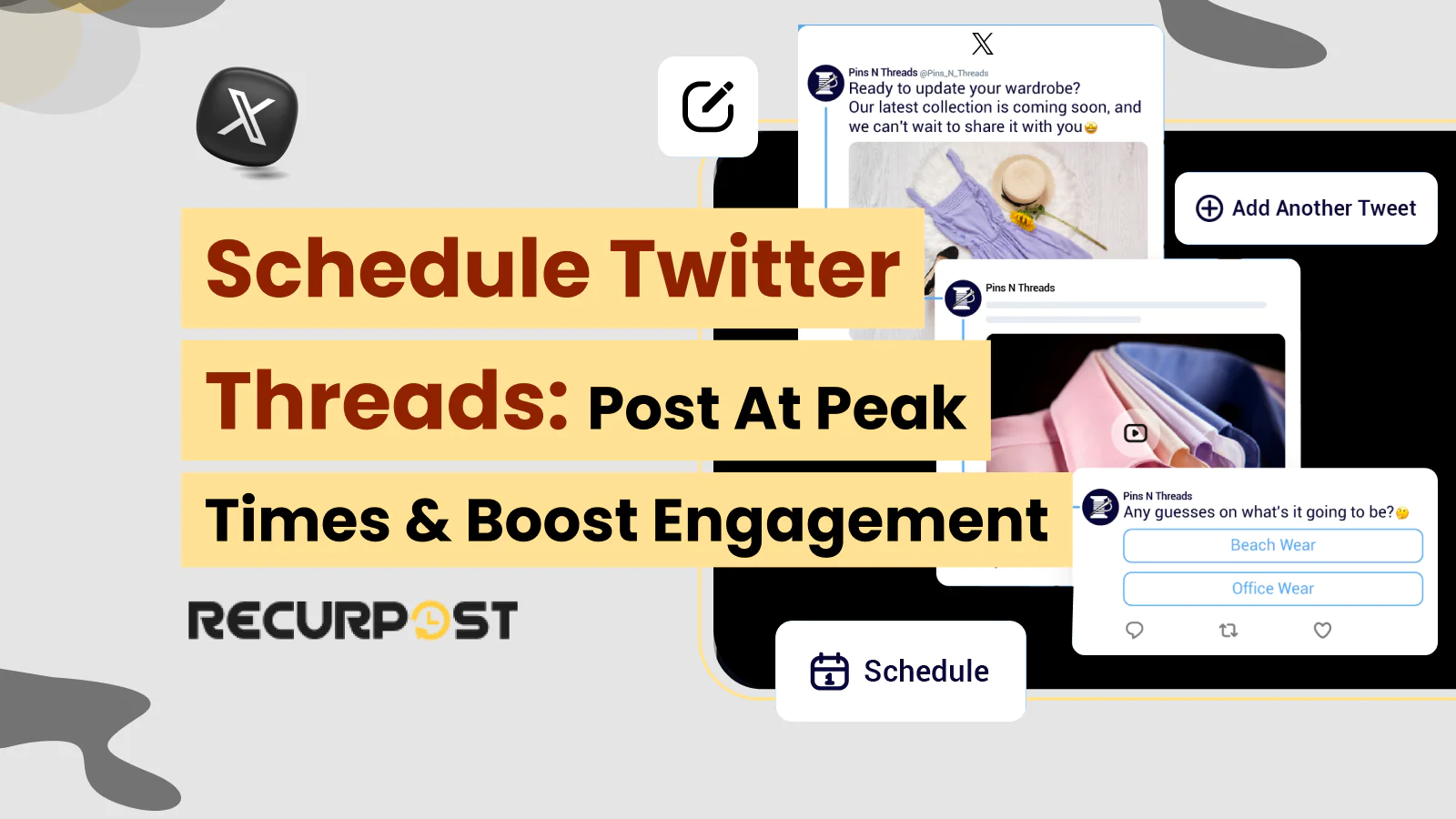Posting a bunch of tweets one after the other can get tricky. You don’t want to spam your followers all at once, but you also want your story to flow nicely. That’s where scheduling Twitter threads comes in handy.
Scheduling Twitter threads means you write all your tweets in advance and set them to post one by one at times you choose. It saves you tons of time and keeps your account active without having to be glued to your phone.
Plus, threads get more attention than single tweets, up to 2.5 times more engagement! In this post, I’ll walk you through how to schedule Twitter threads easily, which tools to use, and some cool tips to get the most out of your posts.

What is Scheduling Twitter Threads?
Scheduling Twitter threads means planning and setting up a group of connected tweets to post automatically in order. You queue them up ahead of time. Then, they publish at the times you choose, keeping your story flowing smoothly.
Each thread has several parts: individual tweets that follow a sequence, timestamps showing when each tweet will go live, and a 280-character limit for every tweet. You can also add images, GIFs, or videos to make your tweets stand out. Hashtags are added to help people find your content more easily.
This is also called planning, queueing, automating, or programming your tweets – setting up your Twitter threads to post without manual intervention.
This differs from manual posting, where you write and share tweets in real-time. Scheduling saves you from rushing or forgetting tweets. It also helps you keep a steady social media presence without being tied to your phone.
Also, educate yourself on how to check a thread on Twitter/X.
Why Schedule Twitter Threads?
Scheduling Twitter threads offers several advantages.
First off, scheduled threads get more attention. On average, they pull in an engagement rate of 5.2%, which is way higher than just posting single tweets. That means more likes, retweets, and comments.
Your threads can reach over 50,000 users when timed right, helping your message travel far beyond your current followers.
Scheduling also saves time. Scheduling cuts down the time spent posting by about 40%. Instead of jumping online every few minutes, you set up your thread once and let automation do the rest.
Using scheduling tools ensures your tweets go out on time 95% of the time. That’s way better than risking missed posts or posting late.
Scheduling works great for all kinds of threads, whether you’re promoting something, teaching your audience, sharing announcements, telling stories, launching products, or giving news updates.
Scheduling Twitter Threads as Part of Your Marketing Strategy
Scheduling Twitter threads fits perfectly into your wider social media and marketing efforts. This approach keeps your account active and audience engaged without constant manual work.
Most marketing teams use content calendars to plan all their social media posts, including threads. Scheduling threads works smoothly with these calendars, making it easy to see what’s going out and when. It also connects well with marketing automation tools that handle posts across multiple platforms.
For teams managing multiple X accounts or social media accounts, scheduling threads saves time and improves organization. It supports maintaining consistency across campaigns and accounts. Social media management tools like RecurPost let you schedule posts, track performance, and manage content all in one place.
Scheduling maintains a consistent social media presence. You can focus more on creating valuable content while automation takes care of publishing and timing. This way, your content strategy stays on track without extra effort every day.
Threads Can Boost Impressions by Over 2,400%
By automating the scheduling of Twitter threads, organizations have experienced a staggering 2,400% increase in impressions. This highlights the potential of automation in amplifying your content’s reach.
Source: Fedica
How to Schedule Twitter Threads: A Step-by-Step Guide
Scheduling Twitter threads is straightforward once you know the process. Here’s how to get started:
1. Plan Your Thread
Decide how many tweets you want in your thread. Most threads are between 5 and 25 tweets long. Think about the order and what you want to say in each tweet. Don’t forget to add images, GIFs, or videos to make your tweets pop. Also, pick hashtags that fit your topic to help more people find your posts.
2. Choose When to Post
Set the date and time for your first tweet. Experts say posting around 9 AM EST can get good results. Make sure to leave at least 15 minutes between tweets so they don’t flood your audience all at once. Planning your schedule about a week ahead gives you time to adjust if needed.
3. How to Schedule a Thread on Twitter/X
Twitter doesn’t let you schedule threads directly on its platform. You can only schedule single tweets there, so to schedule full threads, you need tools made for this.
Did you know you can schedule tweets for better consistency and engagement? While Twitter’s native scheduler has limitations, tools like RecurPost allow you to schedule tweets, automate threads, and even post at the best times using AI, making it easy to schedule tweets on mobile devices.
4. Scheduling Twitter Threads with RecurPost
1. Create a RecurPost Account and Connect Twitter
- Sign up or log in to your RecurPost account.
- Head to the “Accounts” section and connect your Twitter/X account by authorizing RecurPost to access it.
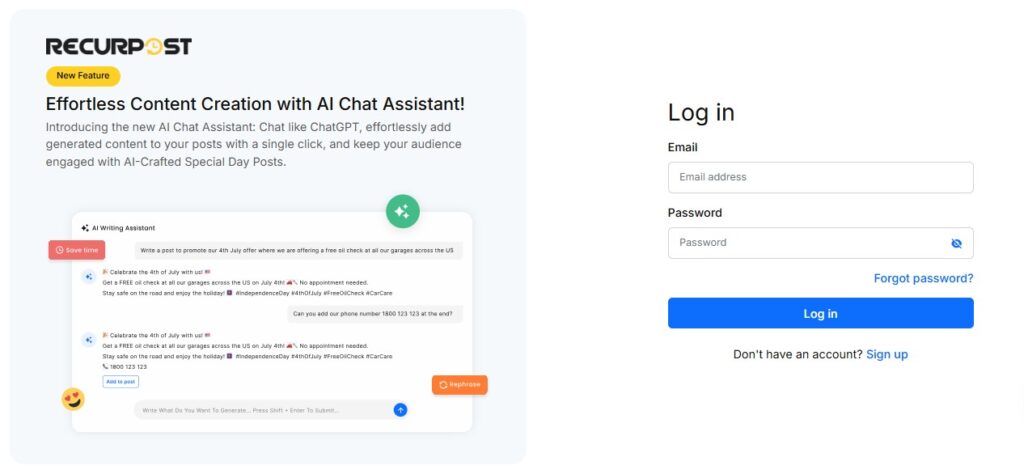
2. Start a New Thread
- Go to the Dashboard.
- Click “Share a Post” and pick the “Create X (Twitter) Thread” option.
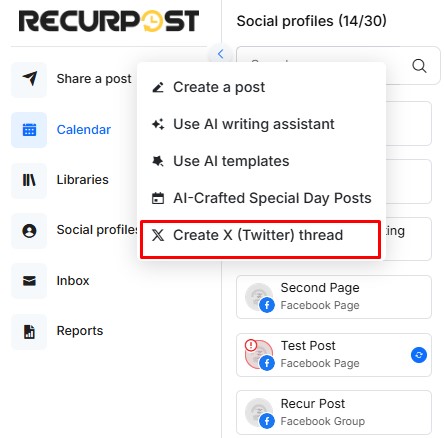
3. Compose Your Thread Tweets
- Write your first tweet, keeping it under 280 characters.
- Click “Add another post” to add the next tweets one by one until your thread is complete (up to 25 tweets).
- Attach media like images, GIFs, or videos. RecurPost supports up to 4 images per tweet.
- Use numbering like “1/10”, “2/10” to show the thread order clearly.

4. Add Hashtags and Mentions
- Include hashtags and mentions inside your tweets to reach more people.
- Use RecurPost’s hashtag suggestions or do your own research for the best tags.
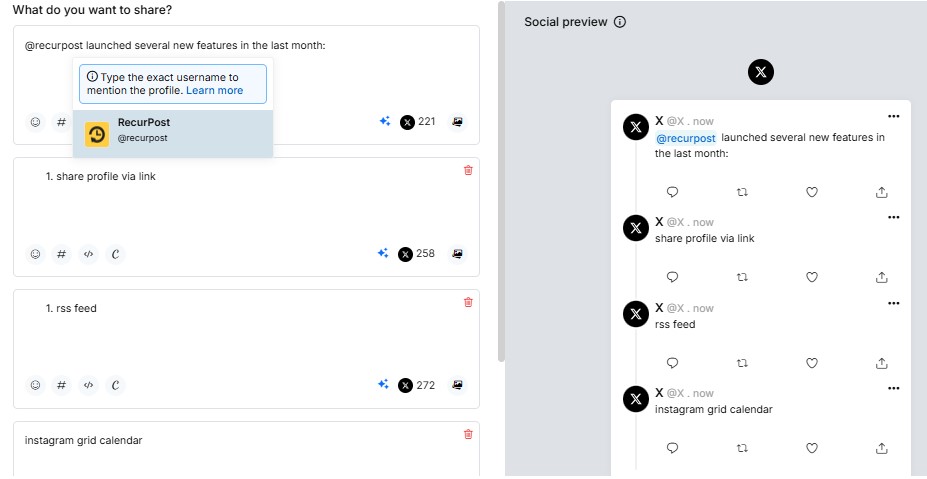
5. Preview Your Thread
- Check the full thread preview to make sure everything looks right, order, content, and media.
- Edit if needed before scheduling.

6. Confirm and Schedule
- Click “Schedule” to queue your thread for automatic posting.
- RecurPost will publish each tweet in order at the times you set.
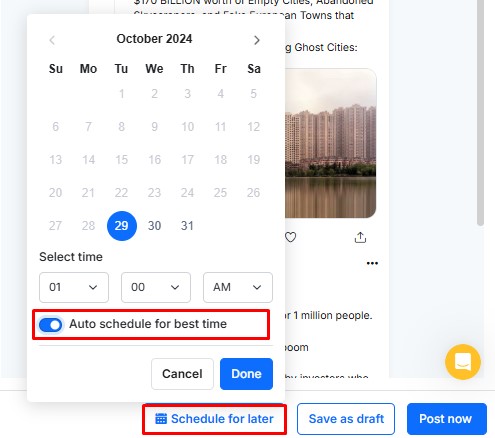
7. Monitor Performance
- Use RecurPost’s analytics dashboard to see engagement, reach, and how well your tweets deliver.
- Use this data to adjust your future threads for better results.

Scheduling threads with tools like RecurPost saves you time and keeps your Twitter account active without constant effort.
Best Practices for Scheduling Twitter Threads
Follow these best practices for your scheduled Twitter threads:
- Start by mixing text with images. Threads that combine words and visuals get more attention and engagement. Don’t just post walls of text; break it up with pictures, GIFs, or videos to keep people interested.
- Keep your thread short but meaningful. Around 10 tweets is a good length. It’s enough to share your message without losing your readers along the way.
- Use 2 to 3 targeted hashtags in your thread. Hashtags help new users find your tweets and join the conversation. Pick ones that match your topic closely.
- Number your tweets clearly, like “1/10”, “2/10”. This helps readers follow your thread in the right order and know how much more is coming.
- Last, keep your brand voice steady across all tweets. Whether you’re casual, professional, or funny, make sure your messaging feels consistent. This builds trust and keeps your audience coming back for more.
Tracking Success and Fine-Tuning Your Scheduled Threads
Tracking your scheduled Twitter threads’ performance helps improve future content.
Monitor metrics like engagement rate, reach, delivery accuracy, and time saved through automation. These metrics indicate your threads’ effectiveness.
Use RecurPost’s analytics dashboard or other tools to check your thread’s results. Look for which tweets get the most likes, shares, or comments.
Use these insights to adjust posting times, refine content, or test different hashtags for greater reach.
Don’t forget to think about your audience’s time zones. Scheduling tweets when your followers are most active, no matter where they live, will help your threads get seen by more users.
Handling Common Challenges When Scheduling Threads
Here’s how to address common challenges when scheduling Twitter threads:
Avoid wearing out your audience by mixing up your thread topics. Change between stories, tips, announcements, and promotions to keep things fresh and interesting.
If you manage multiple X accounts or social media profiles, use a unified scheduling tool like RecurPost. It keeps everything organized and saves time by letting you handle all your accounts from one place.
Remember, scheduled threads shouldn’t replace real-time conversations. Balance your planned posts with live replies and interactions to stay connected with your followers.
Before you schedule, always preview your threads. Testing helps catch mistakes before they go live and keeps your posts looking sharp.
Why RecurPost is the Best Tool for Scheduling Twitter Threads
RecurPost offers simple and reliable Twitter thread scheduling. It handles full automation, so your tweets post on time without you needing to press send every time.
You can add multiple images, GIFs, or videos to each tweet, making your threads more eye-catching and engaging.
The calendar view lets you see all your scheduled posts in one place, making it easy to plan and organize your content.
RecurPost also gives you performance analytics, so you can track how well your threads are doing and make better choices for your next posts.
Whether you want to share educational tips, promote a product, or tell a story, RecurPost supports all kinds of threads to fit your needs.
Conclusion
Scheduling Twitter threads saves time while maintaining an active Twitter presence. It helps your threads get more attention while making your posting process easier.
With tools like RecurPost, you can plan, automate, and track your threads all in one place. Whether you’re sharing stories, announcements, or promotions, scheduling keeps your content flowing without extra hassle.
Start scheduling your Twitter threads today and watch how much more you can engage your audience without spending all day online.
Frequently Asked Questions
1. Can Twitter’s native app schedule full threads?
Twitter’s native app allows users to schedule only a single tweet. It does not support scheduling entire Twitter threads. To schedule full threads, you need to use third-party social media management tools like RecurPost that are built to handle multiple tweets in sequence.
2. Do scheduling tools limit thread length?
Most social media scheduling tools set a maximum of about 25 tweets per thread. This limit helps keep threads focused and easy to follow. While you can post longer threads manually, keeping threads shorter usually keeps your audience more engaged.
3. Can users edit scheduled tweets?
Twitter scheduling platforms generally allow users to edit or delete tweets before they are posted. This means you can adjust your content, add media, or change hashtags after scheduling but before the tweets go live. It’s a good practice to review your scheduled threads to avoid mistakes.
4. Does scheduling affect Twitter’s algorithm ranking?
Scheduling tweets does not negatively impact Twitter’s algorithm. The algorithm mainly looks at content quality and how much your tweets engage users. Consistently posting valuable content, whether scheduled or live, helps keep your account visible.
5. How should users handle replies on scheduled threads?
Scheduled threads post automatically, but user engagement doesn’t happen on its own. You need to regularly check your account to reply to comments and interact with followers. This keeps conversations going and shows your audience you’re active.
6. Can scheduling tools manage multiple accounts?
Tools like RecurPost allow users to manage multiple Twitter/X accounts from a single dashboard. This feature makes it easier for social media managers or businesses to schedule threads and posts across several accounts without switching platforms.
7. What happens if a scheduled tweet fails?
Scheduling tools usually monitor tweet delivery and notify users if any tweet fails to post. If a failure occurs, you can reschedule the tweet or post it manually. This helps avoid gaps in your thread or missed content.
8. When do followers see scheduled thread tweets?
Followers see each tweet in your thread as it posts at the scheduled time. The tweets do not appear all at once but one by one, based on the timing you set. This pacing helps keep your audience interested and engaged throughout the thread.

Saurabh Chaturvedi is a content writer at RecurPost. Specializing in social media management and marketing, Saurabh is dedicated to crafting engaging and informative articles. His passion for clear, exciting content keeps readers eager for more.

